Permaculture companion plants for Common Grape Vine
| Image | Name | Data | Description | Actions |
|---|---|---|---|---|
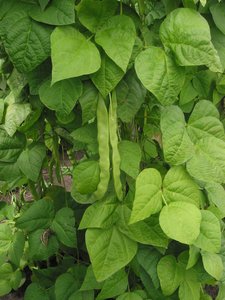
|
Common bean |
2-11
Annual
Full sun
Moist
Light (sandy), Medium, Heavy (clay)
2.0
Vines
Biomass, Dye, antifungal, Nitrogen fixer
true
Leaves, Seed, Seedpod
Seed - transplant, Seed - direct sow
https://en.wikipedia.org/wiki/Phaseolus_vulgaris
Pole bean, Climbing bean, French bean, Bush bean, Dwarf bean, Kidney bean, Green bean
Fabaceae, Leguminosae
Stangenbohne
https://pfaf.org/User/Plant.aspx?LatinName=Phaseolus vulgaris
16-18°c (70-80°f)
6.0-6.8
2.5 cm
16cm
4-10 days
45-85
Fast
Sperzieboon
Costa Rica, Guatemala, Honduras, Mexico Central, Mexico Gulf, Mexico Northeast, Mexico Northwest, Mexico Southeast, Mexico Southwest, Nicaragua, Panamá
Altay, Amur, Andaman Is., Angola, Argentina Northeast, Argentina Northwest, Assam, Baltic States, Bangladesh, Belarus, Bolivia, Bulgaria, Buryatiya, Cameroon, Cayman Is., Central European Rus, Chad, Chita, Colombia, Comoros, Cuba, Czechoslovakia, Dominican Republic, East European Russia, East Himalaya, Ecuador, Ethiopia, Guinea, Gulf of Guinea Is., Haiti, Illinois, India, Iraq, Irkutsk, Jamaica, Jawa, Kazakhstan, Kenya, Khabarovsk, Kirgizstan, Korea, Krasnoyarsk, Kuril Is., Leeward Is., Malaya, Marianas, Maryland, Mongolia, Myanmar, Nepal, New Guinea, New York, Nicobar Is., Nigeria, North Caucasus, North European Russi, Northwest European R, Pakistan, Peru, Philippines, Primorye, Puerto Rico, Queensland, Rwanda, Sakhalin, Senegal, South European Russi, Sri Lanka, Tadzhikistan, Tanzania, Thailand, Togo, Transcaucasus, Trinidad-Tobago, Turkmenistan, Tuva, Uganda, Ukraine, Uzbekistan, Venezuela, Vietnam, Wake I., West Himalaya, West Siberia, Yakutskiya, Zambia, Zaïre
2-4 weeks before last frost
1 week after last frost, 12-14 weeks before first frost
3-5 years
0.4
https://powo.science.kew.org/taxon/urn:lsid:ipni.org:names:514191-1
Coffee, Condiment
|
This entry describes all varieties of the common bean. This includes vining and bush/darf variaties and can have different names depending on their style of growths (see alternate names). These include the kidney bean, the navy bean, the pinto bean, the French bean and the wax bean The common bean, scientific name Phaseolus vulgaris, is a herbaceous annual plant native to the Americas, specifically the regions extending from the southwestern United States to South America. It is a member of the Fabaceae (legume) family. The common bean has a range of different appearances, depending on the variety. Most varieties have a simple, erect stem that grows to a height of 20-60 cm. The leaves are typically green and consist of 3-5 oblong leaflets. The flowers are small and white, pink, or purple in color. The fruit is a legume, which contains the seeds. The common bean is typically a small plant, but some varieties can grow to be quite large, reaching heights of up to 2 meters. The plant grows relatively quickly, with the growing season typically lasting between 60-100 days. The common bean prefers well-drained soil and full sun, but can also grow in partial shade. It is sensitive to frost and should be planted after the last frost date in the spring. To cultivate the common bean successfully, a grower may need to ensure that the soil is adequately fertilized and provide support for the plant to climb, if necessary. The common bean is edible, with the seeds and the young pods being the most commonly consumed parts. The seeds can be cooked and eaten as a protein-rich vegetable, and the young pods can be eaten as a green vegetable. The edible parts can be stored after harvest by drying the seeds or by preserving the young pods in vinegar or oil. The common bean has many uses beyond being a food source. The plant can fix nitrogen in the soil, improving its fertility and making it a useful companion plant for other crops. The dried leaves and stems of the common bean can be used as mulch or as a source of organic matter. In some cultures, the fibers from the stems are used to make ropes or other weaving materials. Additionally, the plant has been used medicinally to treat a variety of ailments. The common bean is also valuable for wildlife. The flowers attract bees and other pollinators, and the plant provides food for a variety of insects, birds, and small mammals. ### Links [Beans Seed Starting Tips @ Harvest to Table](https://harvesttotable.com/beans-seed-starting-tips/) ### Propagation - direct sow Direct-sow beans in spring after all danger of frost has passed and soil is at least 16°C (60°F). In warm-winter regions, sow beans in late summer for harvest in winter. Time sowing so that beans come to harvest before the first frost. |
Show
Edit |

|
White Mustard |
https://en.wikipedia.org/wiki/White_mustard
true
Fast
Moist
Full sun, Partial sun/shade
5-9
Light (sandy), Medium, Heavy (clay)
Brassicaceae or cruciferae
0.6
Weißer senf
Leaves, Seed
Oil, Condiment
Annual
https://pfaf.org/User/Plant.aspx?LatinName=Sinapis alba
5.2
Afghanistan, Albania, Algeria, Altay, Austria, Baleares, Baltic States, Belarus, Belgium, Bulgaria, Central European Rus, China North-Central, China South-Central, China Southeast, Corse, Cyprus, Denmark, East Aegean Is., East European Russia, France, Greece, Hungary, India, Iran, Iraq, Italy, Krasnoyarsk, Kriti, Krym, Laos, Lebanon-Syria, Libya, Manchuria, Morocco, Netherlands, North Caucasus, Northwest European R, Norway, Palestine, Portugal, Qinghai, Romania, Sardegna, Saudi Arabia, Sicilia, South European Russi, Spain, Sweden, Switzerland, Transcaucasus, Tunisia, Turkey, Turkey-in-Europe, Turkmenistan, Tuva, Ukraine, Uzbekistan, Vietnam, West Himalaya, West Siberia, Xinjiang, Yugoslavia
Alabama, Alberta, Amur, Argentina Northeast, Argentina South, Arizona, Azores, Bangladesh, British Columbia, California, Canary Is., Cape Provinces, Chita, Colombia, Colorado, Connecticut, Czechoslovakia, Delaware, District of Columbia, Egypt, El Salvador, Finland, Føroyar, Germany, Great Britain, Greenland, Gulf of Guinea Is., Iceland, Illinois, Indiana, Iowa, Ireland, Irkutsk, Japan, Leeward Is., Madeira, Maine, Manitoba, Marianas, Maryland, Massachusetts, Minnesota, Missouri, Montana, Nebraska, New Brunswick, New Hampshire, New Jersey, New Mexico, New South Wales, New York, North Carolina, North Dakota, North European Russi, Nova Scotia, Ohio, Oklahoma, Ontario, Oregon, Pennsylvania, Poland, Primorye, Prince Edward I., Puerto Rico, Queensland, Québec, Rhode I., Saskatchewan, South Carolina, South Dakota, Tadzhikistan, Tasmania, Tennessee, Texas, Utah, Vermont, Victoria, Washington, West Virginia, Windward Is., Wisconsin, Yakutskiya, Yukon
https://powo.science.kew.org/taxon/urn:lsid:ipni.org:names:288952-1
Cover crop, oil
|
Show
Edit |
|
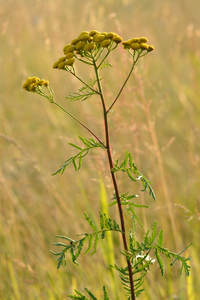
|
Tansy |
3-8
Full sun
Dry, Moist
Light (sandy), Medium, Heavy (clay)
1.0
0.5
Perennial
Herbs
Fast
true
Flowers, Leaves
Common tansy, golden buttons, curly leaf tansy
Rainfarn
Asteraceae or compositae
Albania, Altay, Amur, Austria, Baltic States, Belarus, Belgium, Bulgaria, Buryatiya, Central European Rus, Chita, Corse, Czechoslovakia, Denmark, East European Russia, Finland, France, Germany, Great Britain, Greece, Hungary, Inner Mongolia, Irkutsk, Italy, Japan, Kamchatka, Kazakhstan, Khabarovsk, Kirgizstan, Korea, Krasnoyarsk, Krym, Kuril Is., Magadan, Manchuria, Mongolia, Netherlands, North Caucasus, North European Russi, Northwest European R, Norway, Poland, Portugal, Primorye, Romania, Sakhalin, Sicilia, South European Russi, Spain, Sweden, Switzerland, Transcaucasus, Turkey, Turkey-in-Europe, Tuva, Ukraine, West Siberia, Xinjiang, Yakutskiya, Yugoslavia
Alaska, Alberta, Arizona, Arkansas, Bolivia, Brazil North, Brazil Northeast, Brazil South, Brazil Southeast, Brazil West-Central, British Columbia, California, Colombia, Colorado, Connecticut, Cook Is., Ecuador, Føroyar, Georgia, Iceland, Idaho, Illinois, Indiana, Iowa, Ireland, Kansas, Kentucky, Labrador, Louisiana, Maine, Manitoba, Maryland, Massachusetts, Mauritius, Michigan, Minnesota, Missouri, Montana, Nebraska, Nevada, New Brunswick, New Hampshire, New Jersey, New Mexico, New South Wales, New York, Newfoundland, North Carolina, North Dakota, Northwest Territorie, Nova Scotia, Ohio, Oklahoma, Ontario, Oregon, Panamá, Paraguay, Pennsylvania, Peru, Prince Edward I., Queensland, Québec, Rhode I., Réunion, Saskatchewan, South Australia, South Dakota, Tasmania, Tennessee, Trinidad-Tobago, Tubuai Is., Uruguay, Utah, Venezuela, Vermont, Victoria, Virginia, Washington, West Virginia, Wisconsin, Wyoming
https://en.wikipedia.org/wiki/Tansy
https://pfaf.org/User/Plant.aspx?LatinName=Tanacetum vulgare
https://powo.science.kew.org/taxon/urn:lsid:ipni.org:names:252568-1
0.2
Weed potential
Condiment, Tea
Compost, Dye, Essential Oil, Pest control, Strewing, Dynamic accumulator, Fragrance
|
Show
Edit |
|
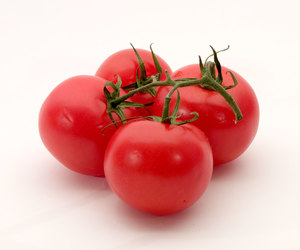
|
Tomato |
10-12
Annual, Perennial
Full sun
Moist
Light (sandy), Medium, Heavy (clay)
2.0
True
Fruit, Seed
https://en.wikipedia.org/wiki/Tomato
Fast
Garden tomato, Dumádu, Garden tomato, Love apple, Lycopersicum esculentum, Tomate, Tomato, Tomato extract containing lycopene, Tomato|thakkali, Tumatis, Lycopersicon esculentum
Solanaceae
Tomate
Oil
https://pfaf.org/User/Plant.aspx?LatinName=Solanum lycopersicum, https://pfaf.org/User/Plant.aspx?LatinName=Lycopersicon esculentum
Start seeds indoors 5-6 weeks before last frost
In containers or in rows in beds around last frost date
6.2-6.8
70-80°f
Peru
Alabama, Alaska, Andaman Is., Angola, Arizona, Arkansas, Assam, Austria, Azores, Bahamas, Bangladesh, Belarus, Benin, Bolivia, British Columbia, Bulgaria, Burkina, California, Cambodia, Cameroon, Canary Is., Cape Verde, Caroline Is., Central African Repu, Chagos Archipelago, Chatham Is., Christmas I., Colombia, Comoros, Connecticut, Cook Is., Costa Rica, Cuba, Cyprus, Czechoslovakia, Delaware, Dominican Republic, East Aegean Is., East European Russia, East Himalaya, Ecuador, Fiji, Florida, Galápagos, Georgia, Gilbert Is., Gulf of Guinea Is., Haiti, Hawaii, Illinois, India, Indiana, Iowa, Ivory Coast, Jawa, Kansas, Kazakhstan, Kentucky, Korea, Laccadive Is., Laos, Leeward Is., Line Is., Louisiana, Madagascar, Madeira, Maine, Malawi, Mali, Marianas, Marquesas, Marshall Is., Maryland, Massachusetts, Mauritania, Mauritius, Michigan, Mississippi, Missouri, Montana, Mozambique, Myanmar, Namibia, Nansei-shoto, Nauru, Nebraska, Nepal, Nevada, New Brunswick, New Caledonia, New Hampshire, New York, New Zealand North, Nicaragua, Nicobar Is., Niue, North Carolina, North Dakota, Nova Scotia, Ogasawara-shoto, Ohio, Ontario, Oregon, Pakistan, Panamá, Pennsylvania, Philippines, Pitcairn Is., Puerto Rico, Québec, Rhode I., Réunion, Saskatchewan, Selvagens, Society Is., South Carolina, South European Russi, Tadzhikistan, Taiwan, Tennessee, Texas, Trinidad-Tobago, Tuamotu, Tubuai Is., Turkey, Turkmenistan, Tuvalu, Utah, Uzbekistan, Venezuela, Vermont, Vietnam, Virginia, Wake I., Wisconsin, Zambia, Zaïre, Zimbabwe
1.00
https://powo.science.kew.org/taxon/urn:lsid:ipni.org:names:316947-2
|
The tomato is a flowering plant native to South America. It is a member of the nightshade family and closely related to the potato. The tomato plant typically grows to a height of 1-3 meters and has a weak, hairy stem. The leaves are arranged alternately on the stem and are typically dark green in color. The plant produces small yellow or white flowers, which develop into the fruit we know as tomatoes. The fruit itself is typically red, but can also be yellow, orange, green, or purple. Indeterminate tomato plants are perennials in their native habitat, but are cultivated as annuals. Determinate, or bush, plants are annuals that stop growing at a certain height and produce a crop all at once. Tomatoes prefer warm, sunny growing conditions and well-drained, humus-rich soil. They can be grown in a variety of soil types, but perform best in soil with a pH between 6 and 6.8. In order to cultivate tomatoes successfully, growers may need to provide support for the plant (such as a stake or cage) to prevent the fruit from weighing down the stem, and may also need to water and fertilize the plant regularly. Tomatoes are generally considered to be frost-sensitive, so in areas with cold winters they may need to be grown in a greenhouse or indoors. There are a great number of cultivars. The edible parts of the tomato plant are the fruit and the leaves. The fruit can be eaten raw or cooked, and is commonly used in a variety of dishes, such as salads, sandwiches, and pasta. The leaves, although not commonly eaten, are also edible and have a slightly bitter taste. After harvest, tomatoes can be stored at room temperature, in a cool place, or in the refrigerator. |
Show
Edit |
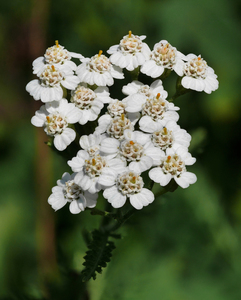
|
Yarrow |
4-8
Perennial
Full sun, Partial sun/shade
Dry, Moist
Light (sandy), Medium, Heavy (clay)
0.6
Herbs
true
Leaves
https://en.wikipedia.org/wiki/Achillea_millefolium
Fast
Boreal yarrow, california yarrow, giant yarrow, coast yarrow, western yarrow, pacific yarrow, bloodwort, carpenter's weed, common yarrow, hierba de las cortaduras, milfoil, plumajillo
Asteraceae or compositae
Gemeine schafgarbe
Weed potential
https://pfaf.org/User/Plant.aspx?LatinName=Achillea millefolium
0.2
Afghanistan, Alabama, Alaska, Albania, Alberta, Altay, Amur, Arizona, Arkansas, Austria, Baltic States, Belarus, Belgium, British Columbia, Bulgaria, Buryatiya, California, Central European Rus, Chita, Colorado, Connecticut, Czechoslovakia, Delaware, Denmark, District of Columbia, East European Russia, East Himalaya, Finland, Florida, France, Føroyar, Georgia, Germany, Great Britain, Greece, Greenland, Guatemala, Hungary, Iceland, Idaho, Illinois, Indiana, Iowa, Iran, Iraq, Ireland, Irkutsk, Italy, Kamchatka, Kansas, Kazakhstan, Kentucky, Khabarovsk, Kirgizstan, Krasnoyarsk, Krym, Kuril Is., Labrador, Lebanon-Syria, Louisiana, Magadan, Maine, Manitoba, Maryland, Massachusetts, Mexico Central, Mexico Gulf, Mexico Northeast, Mexico Northwest, Mexico Southeast, Mexico Southwest, Michigan, Minnesota, Mississippi, Missouri, Mongolia, Montana, Nebraska, Netherlands, Nevada, New Brunswick, New Hampshire, New Jersey, New Mexico, New York, Newfoundland, North Carolina, North Caucasus, North Dakota, North European Russi, Northwest European R, Northwest Territorie, Norway, Nova Scotia, Nunavut, Ohio, Oklahoma, Ontario, Oregon, Pakistan, Pennsylvania, Poland, Portugal, Primorye, Prince Edward I., Québec, Rhode I., Romania, Sakhalin, Sardegna, Saskatchewan, Sicilia, South Carolina, South Dakota, South European Russi, Spain, Sweden, Switzerland, Tadzhikistan, Tennessee, Texas, Transcaucasus, Turkey, Turkey-in-Europe, Turkmenistan, Tuva, Ukraine, Utah, Uzbekistan, Vermont, Virginia, Washington, West Himalaya, West Siberia, West Virginia, Wisconsin, Wyoming, Yakutskiya, Yugoslavia, Yukon
Antipodean Is., Argentina Northeast, Argentina Northwest, Argentina South, Azores, Baleares, Bolivia, Borneo, Botswana, Brazil North, Brazil Northeast, Brazil South, Brazil Southeast, Brazil West-Central, Cameroon, Cape Provinces, Chatham Is., Chile Central, Chile North, Chile South, Colombia, Corse, Costa Rica, Cuba, Cyprus, Dominican Republic, Ecuador, Falkland Is., Free State, Haiti, Hawaii, Honduras, India, Inner Mongolia, Jamaica, Japan, Jawa, Korea, KwaZulu-Natal, Lesotho, Madeira, Malaya, Namibia, New South Wales, New Zealand North, New Zealand South, Nicaragua, Northern Provinces, Northern Territory, Paraguay, Peru, Philippines, Queensland, South Australia, South Georgia, Sulawesi, Sumatera, Taiwan, Tasmania, Uruguay, Victoria, Vietnam, Western Australia, Xinjiang, Zimbabwe
https://powo.science.kew.org/taxon/urn:lsid:ipni.org:names:2294-2
Condiment, Tea
Companion, Compost, Cosmetic, Dye, Essential Oil, Hair, Animal feed, Dynamic accumulator, Ground cover, Fragrance
|
Yarrow (Achillea millefolium) is a perennial plant that is native to temperate regions of the Northern Hemisphere, including Europe, Asia, and North America. It is commonly found in meadows, grasslands, and along roadsides. Yarrow has fern-like leaves that are divided into many narrow, tooth-like segments. The leaves are typically dark green in color and grow in a basal rosette. The plant produces small, white or pink flowers that are arranged in compact, flat-topped clusters. The flowers are attractive to pollinators such as bees and butterflies. Yarrow typically grows to a height of 30-90 cm (12-36 in) and has a spreading habit. It is a fast-growing plant that can quickly colonize an area through its rhizomatous root system. Yarrow is often differentiated from similar plants by its strongly scented leaves and its distinctive flower clusters. Yarrow prefers well-drained soils and full sun to partial shade. It is drought-tolerant and can grow in a variety of soil types, including sandy, loamy, and clay soils. To cultivate yarrow successfully, it is important to space the plants adequately to allow for good air circulation and to prevent the spread of diseases. Yarrow can also be propagated through dividing the root crowns or by planting seeds. Some parts of yarrow, such as the leaves and flowers, are edible and can be used in salads or as a garnish. The leaves have a slightly bitter, astringent flavor and can be used fresh or dried. The flowers can also be used to make tea. It is important to note that some people may experience allergic reactions to yarrow, so it is best to try a small amount first before consuming it in larger quantities. Yarrow has a long history of use in traditional medicine, where it has been used to treat a wide range of ailments, including wounds, infections, and fevers. It is also believed to have anti-inflammatory and astringent properties. In the garden, yarrow can be used as a natural insect repellent, as a mulch to suppress weeds, and as a companion plant to improve the health and vigor of other plants. Yarrow is valuable to wildlife as a nectar and pollen source for pollinators. It also provides shelter and habitat for beneficial insects, such as ladybugs and lacewings, which help to control pest populations in the garden. Overall, yarrow is a versatile and useful plant that can add beauty and functionality to a garden or farm. |
Show
Edit |
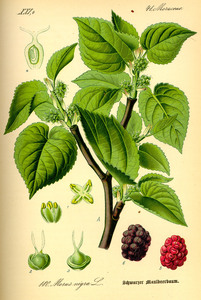
|
Black mulberry |
5-9
Full sun, Partial sun/shade
Moist
Light (sandy), Medium, Heavy (clay)
Deciduous
10.0
4.5
Perennial
Trees
Slow
Dye, Fiber, Lumber
true
Fruit, Shoots
Mulberry, Morus species
Schwarze maulbeere
Moraceae
Iran
Afghanistan, Albania, Algeria, Bermuda, Bulgaria, Canary Is., Cuba, Greece, India, Iraq, Italy, Kazakhstan, Kirgizstan, Kriti, Lebanon-Syria, Leeward Is., Libya, Madeira, Morocco, Puerto Rico, Romania, Spain, Tadzhikistan, Transcaucasus, Tunisia, Turkey, Turkmenistan, Uzbekistan, Vietnam, West Himalaya, Windward Is., Xinjiang
https://en.wikipedia.org/wiki/Morus_nigra
https://pfaf.org/User/Plant.aspx?LatinName=Morus nigra
https://powo.science.kew.org/taxon/urn:lsid:ipni.org:names:854688-1
|
The black mulberry (Morus nigra) is a species of mulberry native to southwestern Asia, including Iran, Afghanistan, and Pakistan. It is a small to medium-sized tree that grows to be about 20-30 feet tall and has a round, dense canopy. The leaves of the black mulberry are dark green and glossy on the top, and paler and slightly hairy on the bottom. The tree produces small, white flowers in the spring, which are followed by black, juicy fruits in the summer. The black mulberry is relatively fast-growing and can reach its full size in about 10-15 years. It prefers well-drained, fertile soil and full sun, but can tolerate partial shade. It is also winter hardy and can withstand temperatures down to about -10°F. The fruits of the black mulberry are edible and can be eaten fresh or used in jams, jellies, and other preserves. They can also be dried and stored for later use. The leaves of the black mulberry can be fed to silkworms, and the wood of the tree is strong and durable, making it suitable for a variety of uses. In addition to its edible fruits, the black mulberry has several other uses. Its leaves can be used as a natural fertilizer, and the tree can provide shade and wind protection in gardens and farms. The black mulberry is also a popular food source for birds and other wildlife. |
Show
Edit |
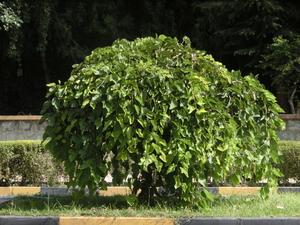
|
White mulberry |
3-9
Full sun, Partial sun/shade
Moist
Light (sandy), Medium, Heavy (clay)
Deciduous
18
13
Perennial
Trees
Medium
Biomass, Dye, Fiber, Animal feed, Wind breaker, Tannin, Lumber
true
Fruit, Inner bark, Leaves, Shoots
Common mulberry
Weiße Maulbeere
Moraceae
Angola, Benin, Cameroon, Central African Repu, Congo, Equatorial Guinea, Gabon, Ghana, Guinea, Guinea-Bissau, Ivory Coast, Kenya, Liberia, Mauritania, Namibia, Nigeria, Senegal, Sierra Leone, Tanzania, Uganda, Zaïre
https://en.wikipedia.org/wiki/Morus_alba
https://pfaf.org/User/Plant.aspx?LatinName=Morus alba
https://powo.science.kew.org/taxon/urn:lsid:ipni.org:names:547653-1
Weed potential
Manna, Tea
|
The white mulberry is a deciduous tree native to northern China, Korea, and Japan. It has large, heart-shaped leaves and small, white or pale pink flowers that grow in clusters. The tree can grow to be quite large, up to 50 feet tall, and it is fast-growing. White mulberry trees can be differentiated from other mulberry trees by their white, rather than dark purple, fruit. White mulberry trees prefer well-draining soil and full sun, but can tolerate partial shade. They are drought-tolerant and can thrive in a variety of soil types. In colder climates, they may need to be protected from frost during the winter months. The fruit of the white mulberry tree is edible and is often used to make jams, jellies, and wines. The fruit can be stored by freezing or canning. Young leaves can also be eaten. White mulberry trees are valued for their fast growth and ability to provide shade. They can be used for wind protection and as a ground cover. The leaves of the tree are sometimes used as animal feed. In some cultures, the bark of the white mulberry tree is used medicinally. Leaves are not frost resistant. |
Show
Edit |
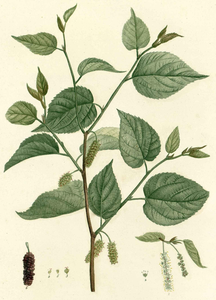
|
Red mulberry |
4-9
Full sun, Partial sun/shade
Moist
Light (sandy), Medium, Heavy (clay)
15.0
4.5
Perennial
Trees
true
Fruit, Leaves, Shoots
Common mulberry, white mulberry
Rote maulbeere
Moraceae
Alabama, Arkansas, Connecticut, District of Columbia, Florida, Georgia, Illinois, Indiana, Iowa, Kansas, Kentucky, Louisiana, Maryland, Massachusetts, Michigan, Minnesota, Mississippi, Missouri, Nebraska, New Jersey, New York, North Carolina, Ohio, Oklahoma, Ontario, Pennsylvania, Rhode I., South Carolina, Tennessee, Texas, Vermont, Virginia, West Virginia, Wisconsin
Bermuda, New Mexico, Turkey, Turkey-in-Europe
https://en.wikipedia.org/wiki/Morus_rubra
https://pfaf.org/User/Plant.aspx?LatinName=Morus rubra
https://powo.science.kew.org/taxon/urn:lsid:ipni.org:names:854710-1
1.5
Fiber, Lumber
|
The Red mulberry, Morus rubra, is native to the eastern United States and Canada. It is a deciduous tree that can grow to a height of up to 80 feet. The leaves are dark green and have a rough texture. The tree produces small, greenish-white flowers in the spring, which develop into clusters of red berries in the summer. The Red mulberry is often differentiated from other mulberry species by its smaller leaves and red berries. It prefers well-drained, moist soil and partial to full sun exposure. It is winter hardy and does not require any special care or maintenance. The fruit of the Red mulberry is edible and can be eaten fresh or used in cooking and baking. The berries can be stored in the refrigerator for up to a week. The tree also has a number of medicinal uses, including as a laxative and for treating sore throat and bronchitis. In terms of wildlife, the Red mulberry is a valuable food source for a variety of birds and mammals. Its fruit is a popular food source for birds such as robins, mockingbirds, and blue jays. The tree also provides habitat for birds and small mammals. |
Show
Edit |
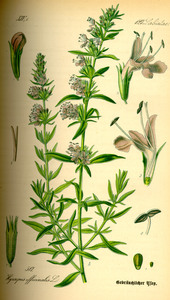
|
Hyssop |
3-11
Full sun
Dry, Moist
Light (sandy), Medium
Evergreen
0.6
0.5
Perennial
Shrubs
Medium
Essential Oil, antifungal, Hedgerow, oil, Fragrance, Strewing, Ground cover
true
Flowers, Leaves, Shoots
Oil, Condiment
True
Lamiaceae or labiatae
Albania, Algeria, Austria, Belarus, Bulgaria, Buryatiya, Central European Rus, Czechoslovakia, France, Greece, Hungary, Iran, Italy, Krym, Morocco, North Caucasus, South European Russi, Spain, Switzerland, Transcaucasus, Turkey, Ukraine, Yugoslavia
Baltic States, Belgium, Great Britain, New York, Poland, Vermont, Wisconsin
https://en.wikipedia.org/wiki/Hyssopus_officinalis
https://pfaf.org/User/Plant.aspx?LatinName=Hyssopus officinalis
https://powo.science.kew.org/taxon/urn:lsid:ipni.org:names:127231-2
True
|
Hyssop is a plant native to the Mediterranean region. It has narrow, dark green leaves and small, blue or purple flowers that bloom in the summer. The plant grows to a height of about 1-2 feet and has a bushy, upright habit. It is differentiated from other plants by its square, woody stem and its aromatic leaves and flowers. In terms of growing conditions, hyssop prefers well-drained soil and full sun. It is drought-tolerant and can be grown in a wide range of climates, including cold, temperate, and Mediterranean climates. To cultivate it successfully, a grower might need to prune the plant regularly to maintain its shape and to encourage new growth. Hyssop is not particularly winter-hardy and may need to be protected from frost or grown in a greenhouse in cold climates. However, it can tolerate light frosts and may return in the spring if it is grown in a sheltered location. In terms of edibility, the leaves and flowers of hyssop can be used in cooking, either fresh or dried. They have a strong, slightly minty flavor and are often used to flavor soups, stews, and salads. The leaves can be stored after harvest by drying them or by freezing them in an airtight container. Hyssop has a number of uses beyond its culinary value. It has been used medicinally for centuries to treat a variety of conditions, including coughs, colds, and digestive disorders. It is also believed to have antibacterial properties and has been used as a natural disinfectant. In the garden, hyssop can be used as a natural insect repellent and can also be grown as a companion plant to help deter pests from other plants. Hyssop is also valuable for wildlife, providing nectar for bees and other pollinators. Its upright habit and colorful flowers make it an attractive plant for any garden, and it is often grown as an ornamental plant for its visual appeal. |
Show
Edit |
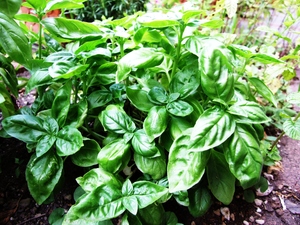
|
Basil |
5-10
Annual, Perennial
Full sun
Moist
Light (sandy), Medium
0.5
Herbs
true
Leaves, Seed
Seed - direct sow
https://en.wikipedia.org/wiki/Basil
Fast
Common basil, Thai basil, Tropical basil
Lamiaceae or labiatae
Basilikum
https://pfaf.org/User/Plant.aspx?LatinName=Ocimum basilicum
Start indoors from late february to mid-summer
Can be grown in containers
1.1
Andaman Is., Assam, Bangladesh, Bismarck Archipelago, Borneo, Cambodia, China South-Central, China Southeast, East Himalaya, India, Jawa, Laos, Lesser Sunda Is., Malaya, Maluku, Myanmar, Nepal, New Guinea, Nicobar Is., Philippines, Queensland, Sri Lanka, Sulawesi, Sumatera, Taiwan, Thailand, Vietnam, West Himalaya, Western Australia
Angola, Bahamas, Benin, Bolivia, Brazil Southeast, Bulgaria, Burkina, Burundi, Cameroon, Canary Is., Cape Provinces, Cape Verde, Caroline Is., Cayman Is., Central African Repu, Chad, Colombia, Comoros, Congo, Cook Is., Cuba, Dominican Republic, East Aegean Is., Ecuador, El Salvador, Eritrea, Ethiopia, Fiji, Gabon, Gambia, Ghana, Gilbert Is., Guatemala, Guinea, Guinea-Bissau, Gulf of Guinea Is., Haiti, Hawaii, Honduras, Illinois, Ivory Coast, Jamaica, Kazakhstan, Kenya, Laccadive Is., Leeward Is., Liberia, Line Is., Madagascar, Malawi, Maldives, Mali, Marianas, Marquesas, Marshall Is., Mexico Central, Mexico Gulf, Mexico Northeast, Mexico Northwest, Mexico Southeast, Mexico Southwest, Mongolia, Mozambique, Nauru, New Caledonia, New York, Nicaragua, Niger, Nigeria, Niue, Oman, Panamá, Primorye, Puerto Rico, Romania, Samoa, Senegal, Sierra Leone, Society Is., South Australia, South European Russi, Sudan, Tanzania, Tokelau-Manihiki, Tonga, Trinidad-Tobago, Tuamotu, Uganda, Ukraine, Venezuela, Venezuelan Antilles, Wallis-Futuna Is., Windward Is., Xinjiang, Zambia, Zaïre, Zimbabwe
After last frost date
15cm
https://powo.science.kew.org/taxon/urn:lsid:ipni.org:names:452874-1
Condiment, Drink, Tea
Essential Oil, Strewing, Fragrance
|
Basil (Ocimum basilicum) is a herb native to tropical regions of Asia and Africa. It is known for its fragrant, green leaves and small, white flowers. The leaves are typically oval-shaped and have a glossy texture. The stem is typically square-shaped and can grow up to 24 inches tall. Basil is a fast-growing plant that prefers full sun and well-drained soil. In colder climates, it is typically grown as an annual, as it is not winter hardy. To cultivate basil successfully, a grower should water it regularly and provide adequate drainage. Removing the last pair of leaves encourages branching and growth. Basil is often differentiated from other plants by its distinctive aroma, which is used in a wide variety of dishes, including pesto, soups, and salads. The leaves, flowers, and stems of the basil plant are all edible, and can be stored by drying or freezing. In addition to its culinary uses, basil has a number of other uses. It has been used medicinally as an anti-inflammatory and to improve digestion. It is also known to attract bees and other pollinators, making it valuable for gardens. |
Show
Edit |

|
Chives |
3-12
Full sun, Partial sun/shade
Moist
Light (sandy), Medium, Heavy (clay)
6.0-7.0
0.3
0.45
Perennial
Herbs
Medium
8-12inches
Seed - direct sow, Seed - transplant, Division
4-6 weeks before last frost
14-21 days
21°c (70°f)
antifungal, Dynamic accumulator, Ground cover, Fragrance
true
Flowers, Leaves, Root
Wild chives, Flowering onion
Schnittlauch
Alliaceae
Allium
Afghanistan, Alaska, Albania, Alberta, Altay, Austria, Baltic States, Belarus, British Columbia, Bulgaria, Buryatiya, Central European Rus, Chita, Colorado, Connecticut, Corse, Czechoslovakia, Denmark, East European Russia, Finland, France, Germany, Great Britain, Greece, Idaho, Iran, Iraq, Irkutsk, Italy, Japan, Kamchatka, Kazakhstan, Khabarovsk, Korea, Krasnoyarsk, Kuril Is., Labrador, Magadan, Maine, Manitoba, Massachusetts, Michigan, Minnesota, Mongolia, Montana, Netherlands, New Brunswick, New Hampshire, New Jersey, New York, North Caucasus, North European Russi, Northwest European R, Northwest Territorie, Norway, Nova Scotia, Nunavut, Ohio, Ontario, Oregon, Pakistan, Pennsylvania, Poland, Portugal, Primorye, Prince Edward I., Québec, Rhode I., Romania, Sakhalin, Saskatchewan, South European Russi, Spain, Sweden, Switzerland, Tadzhikistan, Transcaucasus, Turkey, Tuva, Ukraine, Vermont, Washington, West Himalaya, West Siberia, Wisconsin, Wyoming, Xinjiang, Yakutskiya, Yugoslavia, Yukon
Argentina South, Azores, Belgium, Comoros, Cuba, Dominican Republic, Falkland Is., Haiti, Illinois, Ireland, Jamaica, Maryland, Newfoundland, Seychelles, Trinidad-Tobago
https://en.wikipedia.org/wiki/Chives
https://pfaf.org/User/Plant.aspx?LatinName=Allium schoenoprasum
https://powo.science.kew.org/taxon/urn:lsid:ipni.org:names:528823-1
|
Chives (Allium schoenoprasum) are a bulb-forming herbaceous perennial plants that belong to the same family as onions, garlic, and leeks. They are native to Europe, Asia, and North America, and are commonly grown in gardens for their delicate onion flavor and attractive purple flowers. Chives are easy to grow and require little maintenance. They can be grown in pots or containers, or directly in the ground. The plants have thin, hollow leaves that grow in tight clumps and reach a height of around 12-20 inches (30-50 cm). The bulbs are slender, conical, 2–3 cm (3⁄4–1 1⁄4 in) long and 1 cm (1⁄2 in) broad, and grow in dense clusters from the roots. The scapes (or stems) are hollow and tubular, up to 50 cm (20 in) long and 2–3 mm (1⁄16–1⁄8 in) across, with a soft texture, although, prior to the emergence of a flower, they may appear stiffer than usual. The grass-like leaves, which are shorter than the scapes, are also hollow and tubular, or terete, (round in cross-section) which distinguishes it at a glance from garlic chives (Allium tuberosum). The flowers are pale purple, and star-shaped with six petals, 1–2 cm (1⁄2–3⁄4 in) wide, and produced in a dense inflorescence of 10-30 together; before opening, the inflorescence is surrounded by a papery bract. The seeds are produced in a small, three-valved capsule, maturing in summer. The herb flowers from April to May in the southern parts of its habitat zones and in June in the northern parts. Chives are often used as a seasoning in a variety of dishes, including soups, omelets, and dips. They can also be added to melted butter to make a simple but flavorful sauce for steamed vegetables. Chives are low in calories and a good source of vitamin C, making them a healthy addition to any diet. |
Show
Edit |
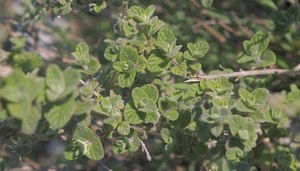
|
Origanum vulgare |
4-10
Full sun, Partial sun/shade
Dry, Moist
Light (sandy), Medium, Heavy (clay)
4.5–8.7
0.6
0.6
Perennial
Herbs
Medium
20cm
true
Flowers, Leaves, Stem
Condiment, Tea
Pot Marjoram
Lamiaceae or Labiatae
Afghanistan, Albania, Algeria, Altay, Austria, Azores, Baleares, Baltic States, Belarus, Belgium, Bulgaria, Buryatiya, Canary Is., Central European Rus, China North-Central, China South-Central, China Southeast, Corse, Cyprus, Czechoslovakia, Denmark, East Aegean Is., East European Russia, East Himalaya, Finland, France, Germany, Great Britain, Greece, Hungary, India, Iran, Iraq, Ireland, Irkutsk, Italy, Kazakhstan, Kirgizstan, Krasnoyarsk, Kriti, Krym, Madeira, Morocco, Nepal, Netherlands, North Caucasus, North European Russi, Northwest European R, Norway, Pakistan, Poland, Portugal, Romania, Sardegna, Sicilia, South European Russi, Spain, Svalbard, Sweden, Switzerland, Tadzhikistan, Taiwan, Tibet, Transcaucasus, Tunisia, Turkey, Turkey-in-Europe, Turkmenistan, Tuva, Ukraine, Uzbekistan, West Himalaya, West Siberia, Xinjiang, Yakutskiya, Yugoslavia
Arkansas, British Columbia, California, Connecticut, Delaware, Illinois, Maryland, Massachusetts, Mexico Southwest, Michigan, New Jersey, New York, New Zealand South, North Carolina, Nova Scotia, Ohio, Ontario, Oregon, Pennsylvania, Primorye, Prince Edward I., Québec, Venezuela, Vermont, Virginia, Washington
https://en.wikipedia.org/wiki/Oregano
https://pfaf.org/User/Plant.aspx?LatinName=Origanum vulgare
https://powo.science.kew.org/taxon/urn:lsid:ipni.org:names:453395-1
best in late Spring; softwood cuttings root fastest
true
Dye, Essential Oil, Pest control, Strewing, Dynamic accumulator, Ground cover, Fragrance
|
Oregano, also known as Origanum vulgare, is a herb that is native to the Mediterranean region. It is a small, bushy plant that grows to a height of about 1 to 2 feet and has a woody stem. The leaves are oval-shaped and are covered in small hairs. The flowers are small and white or purple in color and grow in clusters. Oregano grows best in well-drained, fertile soil in a sunny location. It is winter hardy and can withstand cold temperatures. To cultivate oregano successfully, a grower may need to provide adequate watering and sunlight, and may also need to prune the plant regularly to keep it from becoming leggy. The leaves of the oregano plant are edible and can be used fresh or dried in cooking. They have a strong, pungent flavor and are commonly used in Italian, Greek, and Mexican cuisine. The leaves can be stored after harvest by drying them and storing them in an airtight container. In addition to its use in cooking, oregano has also been used in traditional medicine to treat a variety of conditions, including respiratory problems and digestive issues. It is also known to attract pollinators, making it valuable for wildlife. |
Show
Edit |
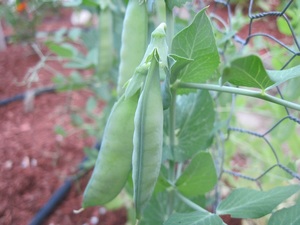
|
Pea |
3-9
Annual
Full sun
Moist
Light (sandy), Medium
2.0
Vines
Nitrogen fixer
true
Leaves, Seed, Shoots
https://en.wikipedia.org/wiki/Pea
Fabaceae or leguminosae
Erbse
https://pfaf.org/User/Plant.aspx?LatinName=Pisum sativum
Afghanistan, Albania, Algeria, Bulgaria, Corse, Cyprus, Egypt, France, Greece, Iran, Iraq, Italy, Krym, Lebanon-Syria, Libya, Morocco, North Caucasus, Palestine, Portugal, Romania, Sardegna, Sicilia, Spain, Transcaucasus, Tunisia, Turkey, Turkey-in-Europe, Turkmenistan, Ukraine, Yugoslavia
Alabama, Altay, Amur, Andaman Is., Assam, Austria, Baltic States, Bangladesh, Belarus, Belgium, Buryatiya, California, Canary Is., Cayman Is., Central European Rus, China North-Central, China South-Central, Chita, Colombia, Costa Rica, Cuba, Czechoslovakia, Dominican Republic, East Aegean Is., East European Russia, East Himalaya, Ethiopia, Fiji, Haiti, Idaho, Illinois, India, Irkutsk, Kamchatka, Kazakhstan, Kenya, Khabarovsk, Kirgizstan, Korea, Krasnoyarsk, Laos, Madeira, Magadan, Marianas, Maryland, Mexico Southwest, Mongolia, Mozambique, Myanmar, Nepal, New Guinea, New South Wales, New York, New Zealand North, New Zealand South, Nigeria, North European Russi, Northwest European R, Oregon, Pakistan, Primorye, Puerto Rico, Rwanda, Sakhalin, South Australia, South European Russi, South Georgia, Sri Lanka, Tadzhikistan, Tibet, Trinidad-Tobago, Tuva, Uganda, Uzbekistan, Vermont, Vietnam, Washington, West Himalaya, West Siberia, Yakutskiya, Yemen
Lathyrus oleraceus
https://powo.science.kew.org/taxon/urn:lsid:ipni.org:names:501912-1
3-5 years
0.3
https://powo.science.kew.org/taxon/urn:lsid:ipni.org:names:60454055-2
|
Peas are a type of legume, native to western Asia and the Near East. They are an annual plant, meaning they grow, flower, and produce seeds within a single growing season. Peas have tendrils that allow them to climb, and their leaves are typically made up of two oblong leaflets and a tendril on a single petiole. Peas produce clusters of small, fragrant flowers that can be white, pink, or purple in color. The flowers give way to pod-like fruits that contain the peas. Peas are a cool-season crop, and prefer to grow in well-drained soil that is high in organic matter. They can tolerate some shade, but will produce the best yields when grown in full sun. Peas can be differentiated from similar plants by their tendrils and the clusters of small, fragrant flowers that they produce. Peas are a relatively small plant, typically growing to a height of one to two feet. They can be grown in rows or as a companion plant, and will typically take between 60 and 90 days to reach maturity. Peas are not winter hardy, and should be planted in the spring as soon as the soil can be worked. Peas are edible, and the seeds inside the pods can be eaten fresh or dried for storage. The leaves and stems of the pea plant can also be eaten, and are a good source of vitamins and minerals. Peas can be used in a variety of dishes, and are a common ingredient in soups, stews, and casseroles. In addition to their culinary uses, peas are also valued for their ability to fix nitrogen in the soil. This makes them a valuable crop for improving soil fertility, and they are often grown as a cover crop or rotated with other crops to improve the overall health of the soil. Peas are also valued by wildlife, and their flowers and seeds are a favorite food for birds and other animals. |
Show
Edit |
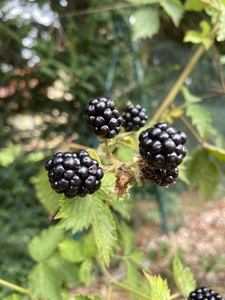
|
Blackberry |
5-9
Perennial
Full sun, Partial sun/shade, Full shade
Moist
Light (sandy), Medium, Heavy (clay)
3.0
Shrubs
true
Fruit, Leaves, Root, Shoots
https://en.wikipedia.org/wiki/Rubus_fruticosus
Fast
Shrubby blackberry, Alish, Baganrra, Bramble, Chanch, Pakana, Rovo, Scepe, Spino, Szeder
Rosaceae
Brombeere
Weed potential
https://pfaf.org/User/Plant.aspx?LatinName=Rubus fruticosus
Rubus
Braam
Brombær
Romania
Austria, Baltic States, Belarus, Belgium, Czechoslovakia, Denmark, France, Germany, Great Britain, Hungary, Ireland, Italy, Netherlands, Norway, Poland, Sweden, Switzerland, Ukraine, Yugoslavia
https://powo.science.kew.org/taxon/urn:lsid:ipni.org:names:736933-1
1
Tea
Dye, Fiber, Pioneer
|
Blackberry (Rubus fruticosus) is a plant native to many parts of the world, including Europe, Asia, North America, and South America. It is a woody, perennial shrub that typically grows to 3-6 feet in height and spreads via long, trailing stems that root at the nodes to form dense thickets. The leaves are typically green and compound, with 3-5 leaflets arranged along the stem. The flowers are white or pink and have 5 petals, and they are followed by the plant's fruit, which are small, black berries that are edible and sweet. In terms of growing conditions, blackberry plants prefer well-drained, fertile soil and full sun to partial shade. They can be grown from seeds or cuttings, and they can be trained to grow along a trellis or fence for support. To cultivate blackberry plants successfully, a grower may need to prune the plants regularly to encourage new growth and remove dead or diseased stems. Blackberry plants are edible and the fruit can be eaten fresh or used to make jams, jellies, and pies. The leaves and roots of the plant can also be used in traditional medicine, and the plant is known to have astringent, anti-inflammatory, and diuretic properties. In addition to their edible and medicinal uses, blackberry plants can also provide valuable habitat and food for wildlife, including birds and small mammals. |
Show
Edit |
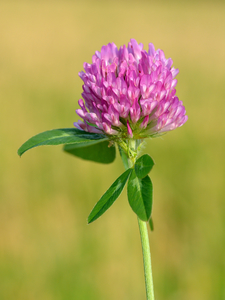
|
Trifolium pratense |
5-9
Perennial
Full sun
Moist
Light (sandy), Medium, Heavy (clay)
0.6
Herbs
true
Flowers, Leaves, Root, Seed
https://en.wikipedia.org/wiki/Trifolium_pratense
Medium
Fabaceae or leguminosae
Roter klee
https://pfaf.org/User/Plant.aspx?LatinName=Trifolium pratense
Afghanistan, Albania, Algeria, Altay, Austria, Azores, Baltic States, Belarus, Belgium, Bulgaria, Buryatiya, Canary Is., Central European Rus, Corse, Czechoslovakia, Denmark, East European Russia, East Himalaya, Finland, France, Føroyar, Germany, Great Britain, Greece, Hungary, India, Iran, Iraq, Ireland, Irkutsk, Italy, Kazakhstan, Kirgizstan, Krasnoyarsk, Krym, Madeira, Mongolia, Morocco, Nepal, Netherlands, North Caucasus, North European Russi, Northwest European R, Norway, Pakistan, Poland, Portugal, Romania, Sardegna, Sicilia, South European Russi, Spain, Sweden, Switzerland, Tadzhikistan, Transcaucasus, Tunisia, Turkey-in-Europe, Turkmenistan, Tuva, Ukraine, Uzbekistan, West Himalaya, West Siberia, Xinjiang, Yugoslavia
Alabama, Aleutian Is., Amur, Antipodean Is., Argentina Northeast, Argentina South, Bahamas, Bermuda, Bolivia, Brazil South, California, Cape Provinces, Chatham Is., Chile Central, Chile South, China North-Central, China South-Central, China Southeast, Chita, Colombia, Colorado, Costa Rica, Cuba, Dominican Republic, Ecuador, Eritrea, Ethiopia, Falkland Is., Guatemala, Hawaii, Iceland, Idaho, Illinois, Japan, Jawa, Kamchatka, Kentucky, Kermadec Is., Khabarovsk, Korea, Kuril Is., KwaZulu-Natal, Labrador, Magadan, Manchuria, Maryland, Mexico Southwest, Minnesota, Nansei-shoto, Nevada, New Mexico, New South Wales, New York, New Zealand North, New Zealand South, Newfoundland, Northern Provinces, Oregon, Peru, Primorye, Puerto Rico, Queensland, Sakhalin, South Australia, Sri Lanka, Taiwan, Tasmania, Tennessee, Turkey, Uruguay, Venezuela, Vermont, Victoria, Washington, Western Australia, Wisconsin, Yakutskiya
https://powo.science.kew.org/taxon/urn:lsid:ipni.org:names:523575-1
Condiment, Tea
Dye, Cover crop, Soil reclamation, Dynamic accumulator, Nitrogen fixer
|
Red clover is a flowering plant native to Europe, Western Asia, and Northwest Africa. It typically grows to about 1-2 feet tall and has trifoliate leaves with a characteristic white or pinkish "V" shape at the base. The flowers are typically a deep pink color and are arranged in compact, spherical clusters. Red clover prefers well-drained, fertile soil and a temperate climate. It can be grown as a perennial in cooler climates, but is often grown as an annual in warmer climates. To cultivate red clover successfully, a grower will need to ensure that the soil is adequately prepared, with adequate moisture and nutrients. Red clover is winter hardy and can tolerate frost. It can be grown as a cover crop to help improve soil fertility and structure, and is often used as a natural source of nitrogen for other crops. It is also used as a source of food for grazing animals. The edible parts of red clover include the leaves and flowers, which can be eaten raw or cooked. The leaves can be stored by drying or freezing, while the flowers can be stored by drying or preserving in syrup. Red clover has a number of medicinal uses, including the treatment of coughs and colds, as well as being used as a natural estrogen replacement. It is also used to improve skin health and as a natural diuretic. Red clover is a valuable plant for wildlife, providing nectar for pollinators such as bees, as well as being a food source for other animals. It is also used by some bird species for nesting material. |
Show
Edit |
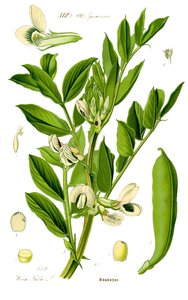
|
Broad Bean |
4-8
Full sun, Partial sun/shade
Moist
Light (sandy), Medium, Heavy (clay)
6.0-6.8
1.0
0.3
Annual
Fast
20cm
Seed - direct sow, Seed - transplant
6 weeks after sowing them in pots
6 weeks after sowing them in pots
21 days
3-5 years
Nitrogen fixer
Leaves, Seed
fava bean, faba bean, Broad bean, or faba bean Varieties with smaller, harder seeds that are fed to horses or other animals are called field bean, tic bean or tick bean Horse bean
Ackerbohne
Fabaceae or Leguminosae
Afghanistan, Iran
Albania, Algeria, Altay, Angola, Argentina South, Assam, Baleares, Bangladesh, Bolivia, Bulgaria, Cameroon, Canary Is., Central European Rus, Chad, China North-Central, China South-Central, China Southeast, Colombia, Corse, Cuba, Cyprus, Czechoslovakia, Dominican Republic, East Aegean Is., East European Russia, Ecuador, Ethiopia, France, Guatemala, India, Iraq, Italy, Jawa, Kenya, Krym, Lebanon-Syria, Leeward Is., Libya, Madeira, Mexico Southwest, Mongolia, Morocco, Myanmar, Nepal, New South Wales, New York, New Zealand North, New Zealand South, Pakistan, Peru, Portugal, Puerto Rico, Rwanda, Sardegna, Sicilia, Spain, Sri Lanka, Sudan, Tibet, Tunisia, Turkey, Turkey-in-Europe, Uruguay, Vermont, Vietnam, West Himalaya, Yemen, Yugoslavia
https://en.wikipedia.org/wiki/Vicia_faba
https://pfaf.org/User/Plant.aspx?LatinName=Vicia faba major
https://powo.science.kew.org/taxon/urn:lsid:ipni.org:names:524737-1
Feb-April; Oct-Nov
sow in deep pots in cool, frost-free place
|
Broad bean (Vicia faba), also known as fava bean or faba bean, is a type of legume that is native to North Africa and the Middle East. It is a popular garden plant, known for its edible beans and attractive purple or white flowers. Broad bean plants have a upright, bushy growth habit and can reach a height of up to 3 feet. The leaves are large and composed of three oval-shaped leaflets, and the flowers are small and clustered in groups of two or three. The beans are produced in long, slender pods that contain two or three beans each. To grow broad beans successfully, it is important to choose a location with well-drained, fertile soil and full sun. The plants should be spaced about 8-12 inches apart, and watered regularly to ensure that the soil stays moist but not waterlogged. Broad beans are generally easy to grow and require little maintenance, but they can be susceptible to pests and diseases, such as aphids and fungal infections. Grows best in temperatures ranging from 60° to 65°F (15-18°C) but will tolerate a range from 40°F (4.4°C) - 75°F (24°C). Broad beans are edible, and the beans can be eaten fresh or frozen, canned or dried for storage. To harvest the beans, the pods should be picked when they are plump and before the beans inside begin to harden. The beans can be removed from the pods by gently squeezing them out. Fresh beans can be stored in the refrigerator for a few days, while dried beans can be stored in an airtight container for several months. In addition to their culinary uses, broad beans also have a number of medicinal properties, and have been used to treat a variety of ailments, including asthma, bronchitis, and anemia. Broad beans are also a valuable food source for many types of wildlife, including birds, insects, and small mammals. The plants provide nectar for bees and other pollinators, and the beans are a popular food for many species of birds. |
Show
Edit |

|
Runner Bean |
1-12
Annual, Perennial
Full sun
Moist
Light (sandy), Medium, Heavy (clay)
3.0
true
Flowers, Leaves, Root, Seed, Seedpod
https://en.wikipedia.org/wiki/Phaseolus_coccineus
Fast
Scarlet runner, scarlet runner bean, scarlet conqueror, fire bean, mammoth, red giant phaseolus coccineus ssppolyanthus (cache bean)
Fabaceae or leguminosae
https://pfaf.org/User/Plant.aspx?LatinName=Phaseolus coccineus
Guatemala, Honduras, Mexico Central, Mexico Gulf, Mexico Northeast, Mexico Northwest, Mexico Southeast, Mexico Southwest, Nicaragua, Panamá
Alabama, Amur, Assam, Baltic States, Bangladesh, Belarus, Bulgaria, Central European Rus, China North-Central, China South-Central, China Southeast, Colombia, Czechoslovakia, East European Russia, East Himalaya, Ecuador, Ethiopia, India, Inner Mongolia, Jawa, Kenya, Khabarovsk, Kirgizstan, Korea, Manchuria, Nepal, New Guinea, New Zealand North, New Zealand South, North European Russi, Northwest European R, Pakistan, Primorye, Rwanda, South European Russi, Tanzania, Transcaucasus, Ukraine, Uzbekistan, Wake I., West Himalaya
3-5 years
https://powo.science.kew.org/taxon/urn:lsid:ipni.org:names:513754-1
Nitrogen fixer
|
Show
Edit |